Amateur guide to deconstructing Hindu temples…
The common denominating factor binding ancient civilisations of Egyptians, Mayans, Greeks, Romans, Chinese and Indians? Temples! But beyond the structural ingenuity and fine craftsmanship of temple architecture lies a deeper science (read common blueprint) alien to the amateur eye. Especially in Hindu temples…where astronomy, astrology, mathematics and metaphysics come together in an enigmatic formula. Know one and you will know all. Ready to break the code?
Its a baffling array of choices across the Indian sub-continent, so go easy on yourself and pick a region first. Recommendation? The west coast, specifically Gujarat…culturally and architecturally the richest, thanks to a spate of foreign invasions. Fine tuning then. Seek authentic Indian, pre-Mughal. Zoom in on the Solanki period for the most outstanding specimens of Indo-Aryan architecture. The object of affection? Sun Temple of Modhera, an 11th-century creation of Solanki King Bhimdev of the Patan empire. Sun-worshipper? But of course!
Coming to name etymology…Modhera is said to named after the Modh community of Brahmins who helped Lord Rama perform a yagna here. Or would you would rather believe the eerie theory that Modhera translates to ‘mound of the dead’ (multiple layers of civilization)? The Sun Temple of Modhera is a two hours (100km) drive from Gujarat’s capital city, Ahmedabad. Easy-peasy. As far as sun temples go, this one is as good as it gets. Much more impressive than its celebrity counterpart at Konark…and two centuries senior too. Archetypal Solanki, right from the intricately carved stone material to all the structural elements. A time-weathered golden brown stone edifice to stun you into a wide-eyed silence, numb you into a zombie-like stupor. But senses on full alert…tons of decoding ahead!


Design decoder: Location, location, location
First things first. It all about a sweet spot…banks of a waterbody, a hilltop, a verdant valley or a green grove, even an island…any icon of earthly paradise. Preferred direction? Always east facing or east to west. To face the rising sun. Isn’t it obvious?
So, here’s how Modhera, being a sun temple, fits the mould. For starters, the main entrance of the temple faces east. But there’s more. It sits right on the Tropic of Cancer that passes through India. Lost? Ok, this is how it pans out. On the days of equinoxes, the Tropic of Cancer receives the strongest, direct rays of the sun. Wait, it gets better. The temple is built in a away that the sunlight travels through the entrance arches at such an angle that it hits the main idol in the dark inner shrine far inside, illuminating it with the power of a thousand lightbulbs. 11th-century genius without support of modern astronomical gadgets. Modhera’s homage to the sun continues through the inverted lotus plinth design. Hint: lotus blooms only in the sun. Head nod?
Design decoder: Concept of cosmos
Pray, worship, serve. Right. But did you know that in its purest sense, the Hindu temple is more than just an abode for the Gods? In the past, it was literally the fulcrum of intellectual, social and artistic life. Part museum, part congregation hall, part learning institution for the community…practically a centre for all-round personal growth. Impressed? That’s not all. As a symbol of the universe, the temple reflected all cosmic elements celebrated in Hinduism, including fire (lighting of oil lamps), water (sprinkled for purity) nature, deities and human life cycle (depicted through sculptures) eternal nothingness (signified by empty space in the shrine) and universality (use of repetitive patterns).
Modhera is no exception to the rule. Get close enough and each stone, each engraving, each pillar, each ledge will start a conversation. Algorithms will emerge from each inch of the marvellous monument. Study the innumerable stone carvings of exquisite celestial beauties, rejoicing figures, rows of elephants and processions of people celebrating life in all its phases, including birth, war, and death. Discover the nuances trapped in the captivating details…12 different Sun idols for 12 months and 52 intricately carved pillars for each week of the solar year. Look out for repetitive, never-ending themes. Towers surrounded by smaller towers, surrounded by still smaller towers for eight or more levels, each part a miniature image of the whole. Observe the geometric patten leading to the massive Surya Kund (stepwell). Consider its symbolism…every part of the cosmos contains all information about the whole cosmos. Reflect on the mountain-like pyramid-shape of the temple’s Shikhar (spire)…an upward movement towards enlightenment? Cross-eyed, no more.
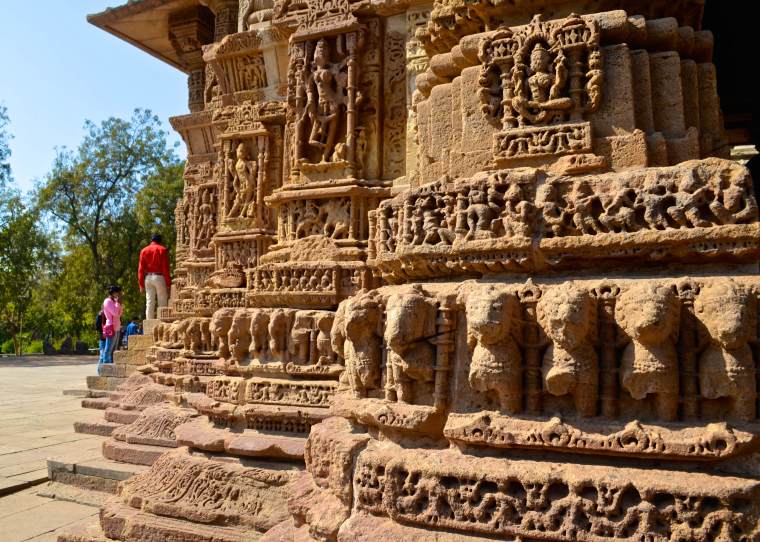





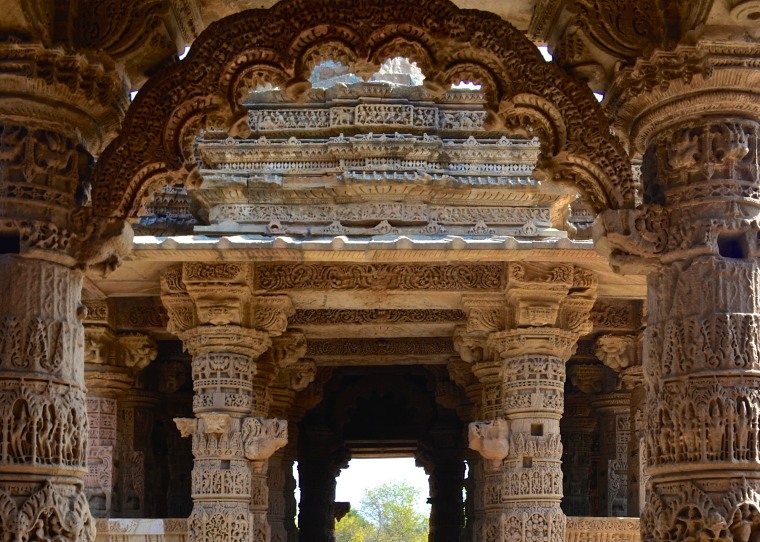
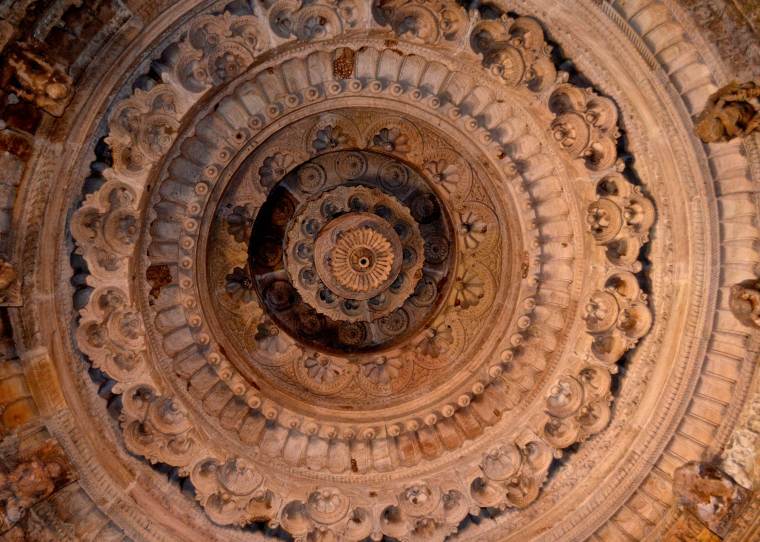
Design decoder: Science of building
Whims and fancies don’t stand a chance, considering that traditional Hindu architecture is based on Vastu Shastra (literally ‘science of architecture’) developed way back between 6,000 and 3,000 BC! A human figure sitting inside a square is used as the model for proportions, much like the 15th-century Vitruvian Man of Leonardo de Vinci. The Vastu-based building employs two shapes for design…squares (for order or space) and circles (for time/movement). Further, influence of sun, magnetic fields and gravitational forces are combined to syncing vibrations of individual with built spaces and the universe. Result? Spiritual strength, peace, bliss. No secret sauce, pure science!
Translate this into each of the three distinct parts of Modhera temple. The Surya Kund (stepwell for purification and salutation) is a perfect square. So is the ‘Garbhgriha’ (sanctum sanctorum that once housed the idol made of pure gold and diamonds. Ditto for the clockwise circumambulation path around the shrine and outer wall. On to each pillar and every portico…suits perfectly. What about the octagonal Sabha Mandap (congregation hall)? Look again, isn’t the octagon a variant of the square too?



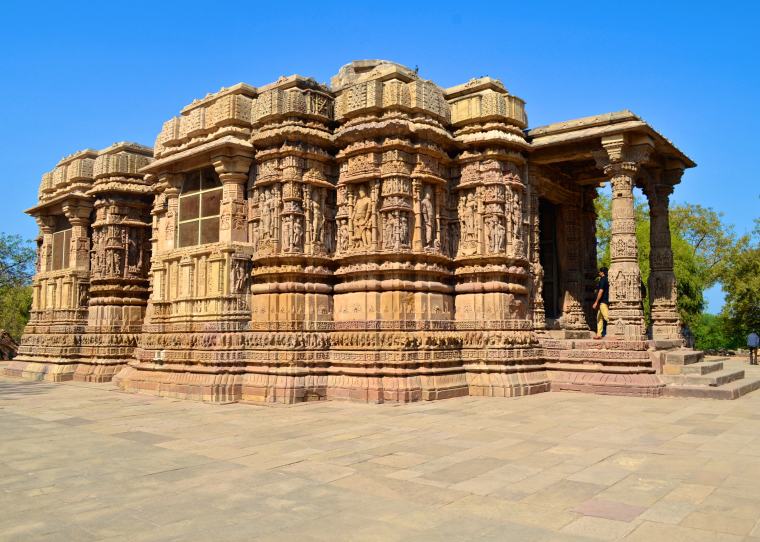
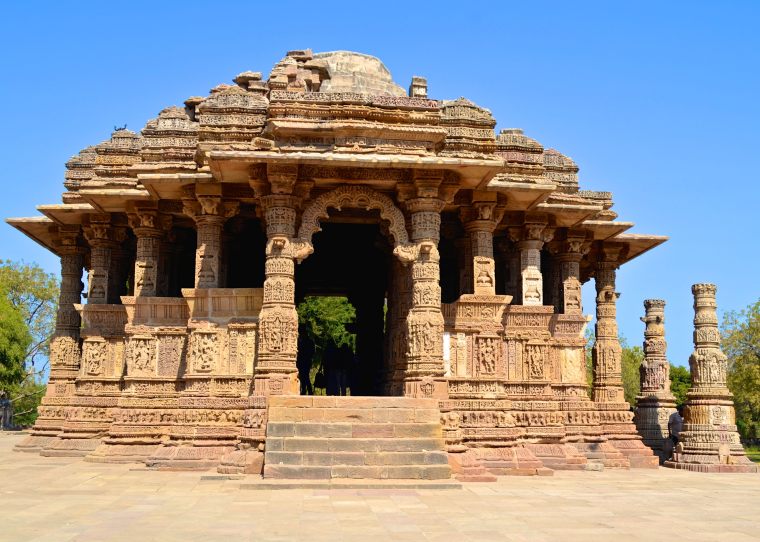
Design decoder: Sense of whole
When you’re exhausted from all the heavy analytics, its time to soak in the full splendour of Modhera from an ideal vantage point. Not somewhere high up, but deep into the recesses of the earth. But where? Take the zigzag descent to the bottom of the Surya Kund from any of the four identical sides. Watch the light dance over the shimmering green water. Slip through the shadows of the shrines dedicated to the pantheon of gods. Take a position opposite the pillared portico of the temple and immerse in the stillness. The grandeur is as overwhelming as it is calming. The temple is the entire universe and you have melted into non-existence. Devotees once dipped into these waters before proceeding to the shrine above. Close your eyes and give into the vision…a deep bed of gold coins, a gold and diamond deity of the Sun God, and a brilliant equinox. Suddenly a pigeon flaps past. Ah…rude return to reality!




Pin this post for later!!

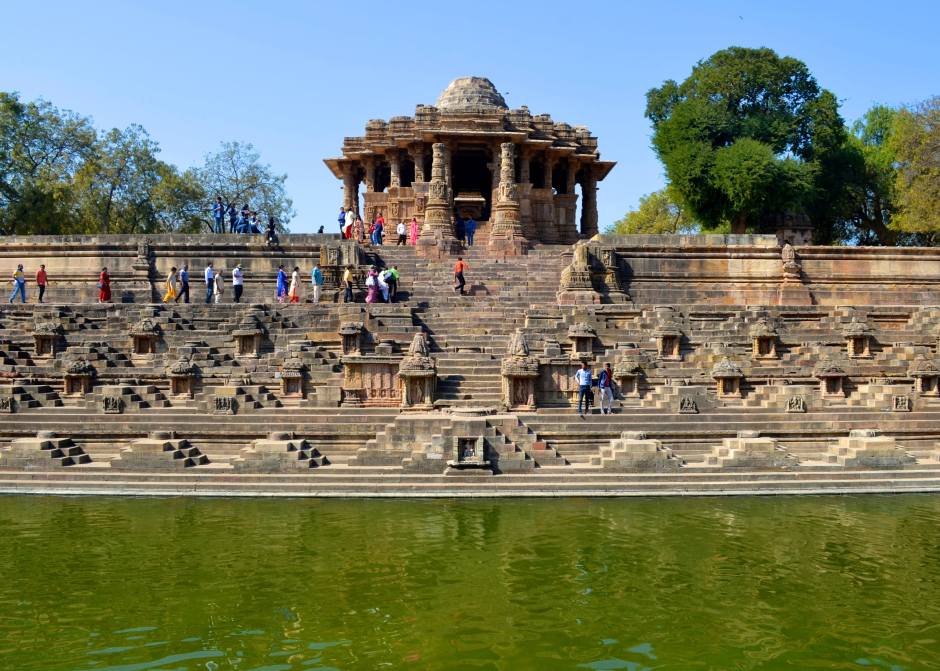
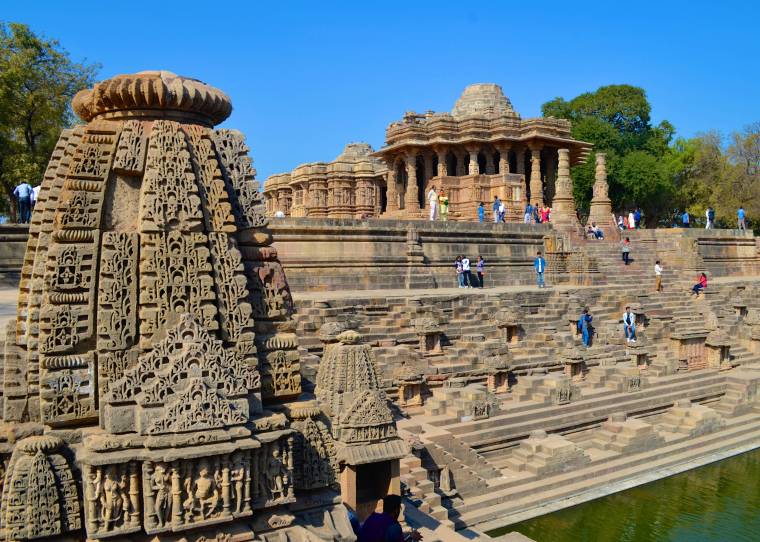




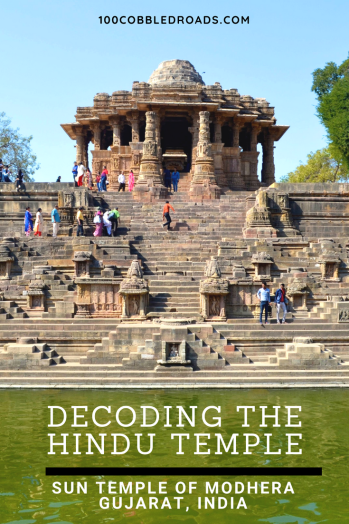

Really nice photo report. Hope to see it by myself :). gr Stef
LikeLike
It will leave you amazed
LikeLiked by 1 person
Beautiful write up and so much to learn. Our history is endless. With amazing photography.
LikeLiked by 1 person
Thank you so much, Namita! Are you an architecture lover too?
LikeLike
This temple is such a work of art and so beautiful, who would have guessed at the complex mathematics and science which informed to design! Thank you for explaining.
LikeLiked by 1 person
Once we go beyond the outwardly appearance, there is so much more to learn!
LikeLike
Having been to Giza, Tikal, Bangkok, and Polonnaruwa, (Chitzen Itza is coming for Christmas), I don’t agree that all temples share the same code. The Hindu and Buddhist temples had levels and levels more encoding and numerology in their designs that what I saw at Giza or Tikal. Every time I go, I learn more secrets. It’s like National Treasure on steroids. You did a great job introducing the decoder ring and, perhaps most importantly, the need to decode in the first place. The grandeur in the details of these temples should be explored and enjoyed.
LikeLiked by 1 person
I meant that within (not across) every civilization, the temple had the same code. The more one explores, the more fascinating architecture gets, don’t you agree? lovely to know we have a common taste in this area.
LikeLike
Can I say this…. Oh my! Oh my! Oh my! What a stunning temple. Now this one has caught my eye and i want to check this out. You really do go to the amazing places in India, places i never even heard off and I cant wait to get out there. India is calling I think 🙂
LikeLiked by 1 person
So glad my India posts are enticing you. We have unending treasures in our country, waiting to be discovered!
LikeLike
I don’t think it would have ever occurred to me that there was a code to break honestly! But it’s interesting to read your process going through the meaning of names, location/regions. Really cool to read how the sunlight hits the main idol in the Modhera without the need for things like electricity! Engravings and algorithms panning out conversations…did you get overwhelmed? I think I would be, it’s a lot but it’s amazing!
LikeLiked by 1 person
Its deeply enriching to go deeper than what we see on the surface while traveling. Sometimes you discover on the spot, and sometimes when you come back and read about it later…
LikeLike
I just love these patterns, details, shapes and just the general though process that has gone into making such a beautiful temple. I love the history, it really is is interesting.
LikeLiked by 1 person
It becomes difficult to decide whether the whole temple is more beautiful or its individual motifs.
LikeLike
There’s so much meaning in everything you see here! Can you imagine how much work went into designing all of the intricate details? It’s overwhelming to try to see them all, but to have thought it through and laid it all out is mind-boggling! This is such a beautiful temple. I’d love to visit it. Especially to see it illuminated with sunlight on the Tropic of Cancer!!
LikeLiked by 1 person
That’s the beauty of Hinduism. There’e meaning and reason for everything, even architecture.
LikeLiked by 1 person
What a fascinating post about the myriad potential meanings and symbolisms of the temple, and the photos really bring out the intricacy of the details. Had never thought about any one temple in this level of meaning!
LikeLiked by 1 person
Thank you so much, Kavita. There is so much depth to our Indian culture and we can keep discovering till eternity but the knowledge will never end!!
LikeLike
Wow, I’ve never heard of the Modhera Temple but it’s very impressive! I like the stone carvings, and the title is very fitting for the post. You’ve done well to decode it, though I was quite lost at times!
LikeLiked by 1 person
Thanks, I’m glad you enjoyed the read.
LikeLike
This is the first time I have enjoyed reading about a temple I knew nothing about! Interesting to know that this sun temple was not only to worship gods, but also acted as a meeting place for intellectuals. The ancient temples really spark my imagination! Especially how they were built and the possibility of ET “help”..
LikeLiked by 1 person
It is really intriguing once you start learning the science and logic behind all these ancient constructions. I barely knew anything about temples myself before I started researching for this post.
LikeLike
Wow! This architecture is amazing! I love all of the detail. Thank you for sharing the story.
LikeLiked by 1 person
Thanks
LikeLike
The Modhera Sun temple is exquisite and part of the enigma that envelops the sun temples of India. Have been to the Modhera Sun temple many years back and also the Konark one a couple of times. Incidentally, last month visited a lesser known sun temple in Katarmal, Uttarakhand, a small one but equally fascinating.
LikeLiked by 1 person
For me, it made a lovely example to understand temple architecture in general. Katarmal sounds interesting.
LikeLike
This is absolutely fascinating, Punita, and I love the way you bring it to life. I absolutely adore ancient architecture, especially the algorithms and the science behind it. Wish I knew more about it. Having read your blog, well, now I do. I especially find it fascinating how ancient civilisations could carry off feats such as having “the sunlight travel through the entrance arches at such an angle that it hits the main idol in the dark inner shrine far inside, illuminating it with the power of a thousand light bulbs.” Brilliant engineering!
LikeLiked by 1 person
Thanks so much for your lovely comment, Priya! Researching for this post was an absolute delight. We know just a fraction about Indian heritage and culture…there’s so endless knowledge waiting to be taken in!
LikeLike
The Sun Temple of Modhera not only looks amazing but beautiful as well, that is interesting about what it means. I just love ancient architecture and I want to add this place to my list next time that I am in India.
LikeLiked by 1 person
Its a glorious piece of architecture and you will enjoy exploring every inch of it.
LikeLike
You definitely did your homework! Impressive temple, these structures always have a life of their own. Glad to see that it is very well preserved.
LikeLiked by 1 person
The homework made it even more worthwhile!
LikeLike
Why I have this feeling that the last scene of Sanjay Dutt’s Bhoomi was shot here. Bt anyways, the temple is amazing and its architecture looks one of its kind.
LikeLiked by 1 person
Thank you for stopping by!
LikeLike
The Sun Temple of Modhera looks amazing. I am wondering how people of those days could make such an architectural wonder that sun-rays falls on the deity inside.
LikeLiked by 1 person
That thought in itself is enough to make a visit.
LikeLike
What an interesting temple! Using the human figure as the model for the building proportion. So ingenious! The temple’s structure looks amazing too.
LikeLiked by 1 person
That’s the blueprint for all Hindu temples, not just this one, Marvi.
LikeLike
WOW! I love the details of the temple. It is hard to find something like this in today’s world. Keep exploring
LikeLiked by 1 person
Today’s world can even never get close.
LikeLike
These are gorgeous temples. I wonder if those sculpture have meanings. You are very lucky to pay them a visit!
LikeLike
I am glad I did not write on this temple! You have written with such details that no one can match it. 🙂
Beautiful write up and there’s so much to learn. Great work girl.
LikeLiked by 1 person
Thank you so much Nisha! Writing deeper is challenging and it is comments like these that make it worthwhile. 🙂
LikeLiked by 1 person
Thank you for the guide to decoding Hindu Temples. My wife and I have been to many temples in India during our travels and I can’t believe how many details we missed! Now we’ll have to go back and check them out again to see what we overlooked the first time! I’ll be keeping my eye out for Vastu Shastra from now on.
LikeLiked by 1 person
Thanks for your lovely comment, Stevo. Everything in India hides so many meanings that are not always evident on the surface. We ourselves keep discovering newness in our country everyday 🙂
LikeLike
We had been there a few years back. Your awesome photos and article has made me relive those moments. The science behind these architectural wonders never fails to interest me. I always wonder, how in those days with minimal instruments, machines and tools, they could build them.
LikeLiked by 1 person
Thanks so much Nisha! Yes, the brain does go ticking while admiring these wonderful creations.
LikeLike
Modhera is just so so gorgeous. Each of those carved pillars has a story to tell. Amazing to note the science of how the light travels through the temple. Goes to show how advanced that generation was. Beautiful pictures and a lovely post
LikeLiked by 1 person
Thanks Ami. It was a surreal experience sitting on the steps of the Surya Kund.
LikeLike
The temple has fantastic architecture! And it has been so well preserved, considering it dates back thousands of years. I have not been to Gujarat as yet, it’s one of the few states in India that I haven’t explored and there is a lot to see there! Adding this historical temple to my list, thanks for the recommendation.
LikeLiked by 1 person
Gujarat is one of our richest in terns of architecture. A must visit for history buffs.
LikeLike
Beautiful article
LikeLiked by 1 person
Thank you so much, Hiren!
LikeLiked by 1 person
Thinking to go this place next month. This one will help 😀
LikeLiked by 1 person
Enjoy your trip
LikeLiked by 1 person
Wow! You just reminded me of one of my cherished trips to Gujarat. Modhera made me speechless. I remember packing off my camera and sitting in the middle of the hall with so much art all around me and I didn’t know what to photograph!!!
LikeLiked by 1 person
Modhera is quite a fascinating gem, isn’t it?
LikeLike
Such a beautiful temple.Hope to go there in future. I love temple carvings a lot and trying to visit all that i can. Great post.
LikeLiked by 1 person
Modhera is a masterpiece!
LikeLiked by 1 person